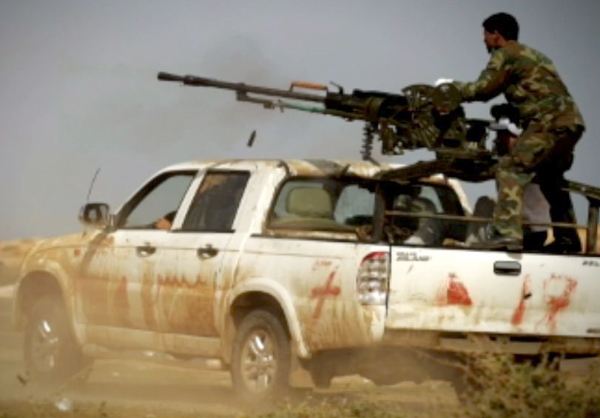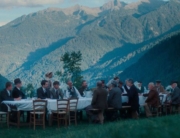
A scene in Libya by photographer Finbarr O'Reilly
Directed & Written by Martyn Burke
Produced by Burke & Anthony Feinstein
Released by Mercury Media Entertainment
Canada. 90 min. Not Rated
Director Martyn Burke interviews nine gutsy men and women who make possible the claim that “The whole world is watching” and reveals the personal cost of bringing first-hand information of conflict and war beyond borders.
Their very personal accounts range over decades from countries where children can be perpetrators and victims, translators can provide nick-of-time warnings or be inadvertent targets (one such awful attack was caught on film). The correspondents proudly rattle off the physical protections they take, but the bravado quickly deflates at a London church funeral at the Journalists’ Altar and Ian Stewart’s description of getting shot in the head when he worked for the Associated Press in West Africa. Identified with the long list of conflict zones they’ve covered—Afghanistan, the Congo, Chechnya, El Salvador, Lebanon, Liberia, Libya, Rwanda, Sarajevo, and Sierra Leone—each talks from a dark room, with footage and photographs of their striking work projected behind them.
Producer Toronto psychiatrist Dr. Anthony Feinstein, author of Journalists under Fire: The Psychological Hazards of Covering War, explains the emotional impact on frontline non-combatants (he was a medic in South African wars). After witnessing horrors that are seared in their brains, their adjustment to life back home in first-world cities is difficult. The interviewees consider whether they are or are not adrenaline junkies, but most concede there’s an addictive aspect to their work. Some admit to posttraumatic stress disorder (PTSD), while others deny it—then go on to describe classic symptoms of rage and vivid nightmares that border on hallucinations. TV news videographer Jon Steele, whose memoir is called War Junkie, recalls “We didn’t call it PTSD back then, we called it ‘I need a drink.’” Most have written books about their exciting experiences and excerpts run on the screen as they read them aloud—Steele hands his copy to Burke to continue as he gets too choked up at his own memories.
The (surviving) photographers who were portrayed in Steven Silver’s recent fictionalization of The Bang Bang Club were not interviewed, but their significance is marked (photographer João Silva stepped on a mine in Afghanistan a year ago, losing his legs). The tragic fate of his South African colleague Kevin Carter is mulled over as a prominent example of the toll of guilt and responsibility for their reports. They reflect on their own, but they insist that each brings individual problems to the job. Other than Chris Hedges talking about leaving war reporting for The New York Times to save his sanity, there is little biographical background into how they got into this line of work.
While several men cite the macho ethos that keeps them going (ignoring competitive one-upmanship), two women correspondents field questions about their perspective as working mothers. One testily asks Burke if he’s queried the men about how their work affects them as fathers—and he doesn’t. (Several of the men acknowledge relationships and marriages have fallen apart due to their frequent travel.) In terms of how their personal safety concerns are different, one woman jauntily notes the need to have modest dress and sharp elbows to fend off gropers in Middle Eastern crowds, an insight into CBS correspondent Lara Logan’s notorious assault in Tahrir Square earlier this year and several more last week.
The documentary’s opening statistic that only two journalists were killed in World War I is sadly quaint compared to the closing sweep of the huge memorial wall of portraits at Washington, D.C.’s Newseum, dedicated to those killed working in action since. Some of the missing historical context can be seen in Trisha Ziff’s informative The Mexican Suitcase, now making the film festival rounds, which traces the experiences of daring men and women photographers fatally embedded in the 1930’s Spanish Civil War and how their powerful images were saved. Under Fire: Journalists in Combat pays sympathetic tribute to the very human individuals behind today’s influential work who continue that important tradition at great risk to their physical and psychological health.






Leave A Comment